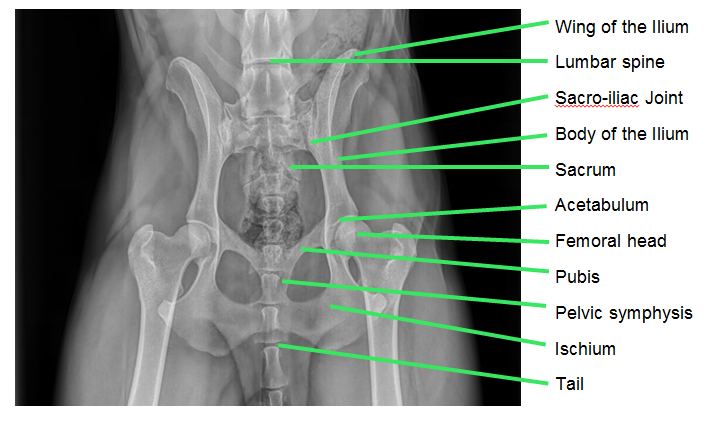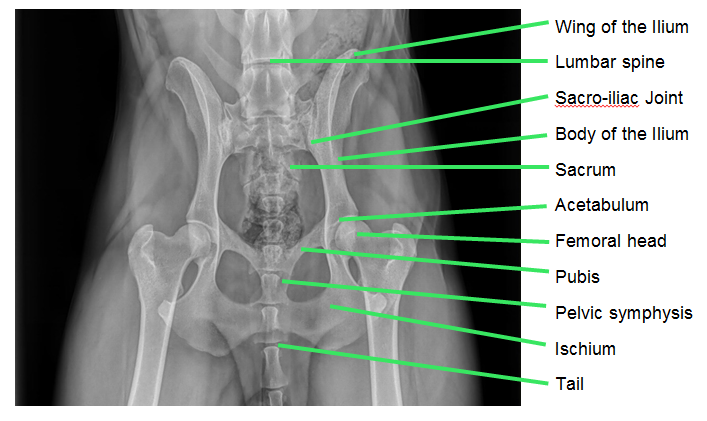This article gives a simple overview of what to expect when a pet has a pelvic fracture, what are the most common causes and associated injuries, and what treatment options are available.
Pelvic Fractures are a fairly common occurrence and it is something veterinarians in private practice are faced with almost on a weekly basis. The pelvis is an essential part of a pet’s skeletal structure and forms the framework around which their hind limbs move and function. Not only is it essential to our pets ability to walk but there are some very sensitive and important structures that lie in and around the pelvis which can easily be damaged in the event of a pelvic fracture. This will be explained in more detail later on in the article.
Understanding the structure of the pelvis and how it interacts with the surrounding bones and soft tissues will help to put the various fracture types into perspective. The following demonstrates the basic anatomy of the pelvis:
Now that a picture can be formed in the mind about which part belongs where, understanding pelvis fractures is made easy. The first thing to note is that the pelvis forms a box with the left and right parts being equal. For this reason the pelvis will not displace if only a single fracture has occurred, if one half of the pelvis is displaced then at least 2 fractures must have occurred. The pelvis must fracture in three places for displacement to occur. All areas of the pelvis may be affected. The most important regions of the pelvis that may be affected is the acetabulum (the socket of the hip joint) as well as around the sacro-iliac joint region. These areas have many important nerves from the spine and blood vessels enter the hind limbs exposing them to injury should pelvic trauma take place.
As mentioned before there needs to be at least 3 fractures for displacement to take place.The advantage is that should there only be a single fracture, provided no other complication is present, it may in certain cases, once a proper assessment has been done by the vet, be left to heal without surgery as the remainder of the pelvis will act as splint keeping everything where it should be. With a fracture through the joint socket or acetabulum and where the joint is affected, the advice of a specialist surgeon may be sought because if it is not fixed correctly, the development of arthritis in that joint is inevitable. If there is severe displacement of the pelvis, surgery will have to be performed to correct the malalignment and stabilise the pelvis. Separation of the pelvic symphysis (area where the 2 halves of the pelvis are joined) is a fairly common fracture seen in young dogs and cats where this symphysis has not completely calcified. Separation or dislocation of the hip from the spine (sacrum specifically) can occur, but as mentioned before, this displacement may only occur if there is at least 1 other fracture present or both sacro-iliac joints have been dislocated. Displacement of the pelvic girdle can occur with both sides of the pelvis separates at the sacroiliac joints from the spine or with fractures of the pelvic bones in three sites, or a combination of the two. This is only a very brief overview of some examples of pelvic fractures and there are many different variations with different outcomes that can occur.
The most common cause for pelvic fractures is when our pets get hit by cars. Other potential cause include any trauma severe enough to break bones, including falling from heights, bite wounds or trauma (especially small dogs and cats attacked by large dogs), falling off moving vehicles, abuse and just about any traumatic incident severe enough to cause that amount of damage. As trauma is the major cause of pelvic fractures and the intensity of that trauma is severe enough to break bones, there is usually a lot of damage to the associated soft tissues both around the hips and in distant areas such as the lungs. Important tissues to pay careful attention to in the pelvic region include the nerves running form the spinal cord, the bladder, the urethra (tube running from bladder to genitalia), rectum and anus as well as all the surrounding muscles. Nerve damage is a very unfortunate complication of pelvic trauma and if severe enough cannot be corrected. This may leave your pet paralysed in one or both hind limbs (although this is relatively rare), or may cause a loss of anal or bladder tone, resulting in urinary and faecal incontinence (loss of bladder or anal control). Should the bladder or urethra be damaged or ruptured there can be leakage of urine into the surrounding tissues with severe complications due to the irritant nature of urine. In these cases surgical correction is often required. Bleeding and bruising of surrounding tissues may be the result of ruptured blood vessels or severe tissue trauma and this can be very painful and debilitating to your pet. Lastly whenever an animal is hit by a car or severely traumatised the lungs may also be affected with lung contusions (injury), pneumothorax (air in chest cavity) and bleeding into the chest being a possibility. Some studies have shown that there is a high occurance of lung trauma (up to 58%) when there is pelvic trauma. The vet may therefore suggest that chest X-rays (radiographs) are taken and a patient be treated with oxygen and carefully monitored. If the animal isn't hospitalised the vet may request that the animal be brought back for follow-up chest radiographs 48 – 72 hours after the incident, as lung contusions may only show up later. One should be careful not to only focus on the fractures in the pelvic bones themselves, as there is a large amount of soft tissue (muscle, nerves, organs) in the body that may also be affected.
The treatment of pelvic fractures, unless stable and minor, will require surgery of some sort. In some instances where there is only a single fracture or minor displacement, strict cage rest may be recommended by the vet. This is a long term process as bone can take up to 6 weeks to knit properly at a fracture site and even then complications may still be present. If the knitting has taken place properly, remodeling of the bones take another 6 to 12 weeks depending on the age of the animal. Should the acetabulum be involved or there is severe displacement, surgery is the only treatment to be considered. Whichever course of action is to be taken it is always wise to consult with a specialist surgeon when making the appropriate decisions. Surgical repair of pelvis fractures is by no means a quick fix and it is important to understand from the start that it is a long term and costly procedure that you as a pet owner should be prepared for.
© 2018 Vetwebsites – The Code Company Trading (Pty.) Ltd.



